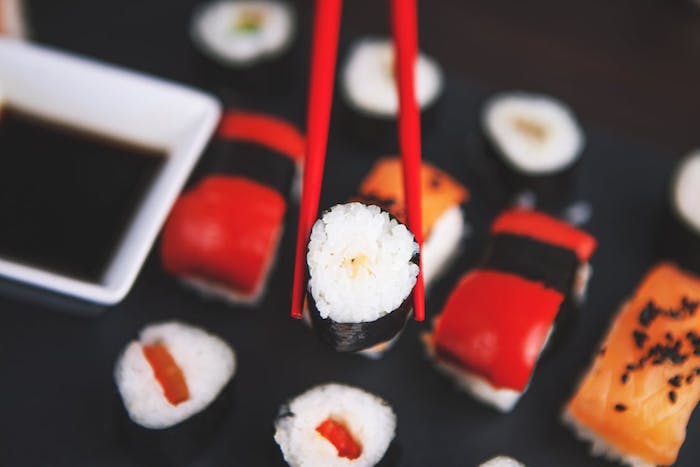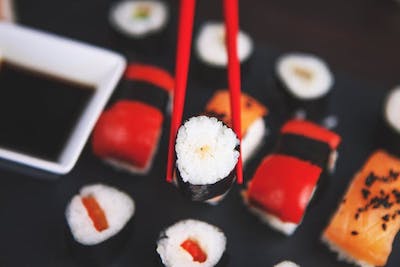We are reader supported. When you purchase through links on our site, we may earn an affiliate commission. Also, as an Amazon affiliate, we earn from qualifying purchases.

I have known Japanese cuisine for several years now and I can safely say that the Japanese are as particular about their food as they are about anything else. While sushi may be a mere delicacy for you, it’s a culinary art for them, prepared for generations and there are a bunch of rules related to preparation, consumption, and presentation.
My American friends often ask me ‘do you put wasabi in soy sauce’ and my answer is ‘No’ if you want to enjoy this delicacy as per the traditional norms. But, today, it is common to see non-Japanese breaking those rules and adding wasabi to soy sauce to experiment with the flavors. Although technically incorrect, it’s acceptable in a few places but a good sushi chef will never approve of it.
The fact is, the sushi chef already adds the right amount of soy sauce and wasabi to the sushi to ensure that they do not overpower the subtle flavors of fish and vinegared rice. Sushi chefs practice the art for years to gain the skill of striking the perfect balance of all ingredients.
Contents
The Correct Way Of Eating Wasabi
When you eat sushi, it is more polite to trust what your chef gives you and appreciate the different flavors, which may otherwise get drowned in the heat of wasabi. This gives you the opportunity to better enjoy this age-old delicacy. You may ask – why do they serve the green paste with sushi then?
Instead of adding wasabi to your soy sauce, I would suggest that you take a bite of your sushi and then add a blob of wasabi on one side of your sushi roll or nigiri if needed. Dip the other side in soy sauce and eat. Don’t ever try to eat wasabi alone as it can make your mouth burn and eyes water.
If you are a newbie, here’s a quick tip for you. Make sure you don’t let wasabi come in direct contact with the soft palate inside the mouth as this may cause discomfort. As a beginner, just go with the amount of wasabi chef already adds to your sushi.
These days real wasabi is rare to find and most restaurants serve the fake or imitation wasabi made from horseradish, mustard, cornstarch, and green food coloring. Some restaurants may use dried spinach powder in the place for green coloring.
I have created an article that explains what wasabi is made of and the difference between real and fake wasabi. Read it here.
Soy Sauce Dilutes The Effect Of Wasabi
Another version of why you must not put wasabi in soy sauce says that it’s got nothing to do with etiquettes. It’s actually much simpler and easier to understand. According to this version, if wasabi is soaked in soy sauce, the actual characteristic sting effect of the condiment is lost.
Thus the end result you get by mixing wasabi and soy sauce does not serve the actual purpose of adding heat to the dish. When you keep the two separate and dab a little wasabi on the fish and wet one side of the sushi rice in soy sauce, you will find that the taste of wasabi is much stronger.
3 Reasons To Avoid Mixing Wasabi To Soy Sauce
As the sushi culture spread outside Japan, it soon became a sought after delicacy across the world. It’s widespread popularity and accessibility has led people to come up with different variations of sushi containing non-traditional ingredients.
As sushi becomes more westernized, people forget the basic etiquettes and prefer to eat as they like. However, it is important to understand that the etiquettes are not just made to respect the chef and Japanese traditions, but help you enjoy your sushi meal to the fullest. Here are the three reasons to avoid mixing wasabi to soy sauce.
#1. It spoils the perfect taste of soy sauce
As you may already know, soy sauce is an important condiment used in a variety of traditional dishes and the Japanese have a special regard for this condiment. It’s rude to sit in a Japanese restaurant and spoil the legit flavor of soy sauce served to you. In some restaurants, the chefs may handpick the best quality soy sauce to give you a taste of authentic Japanese food and by spoiling the taste, you disregard their culture
#2. The taste of wasabi is ruined
Well, I agree that most of the restaurant serve fake wasabi instead of the real thing, but even then the paste made of horseradish and fillers is prepared to closely replicate the real taste. Some of the high-end restaurants may actually use the real wasabi stem to grate it and serve the authentic green paste to you. By mixing it to soy sauce, you disrespect the effort put by the chef who creates an edible art for you.
#3. The end result is not pleasing to the eyes
Have you ever noticed how pleasing sushi is to your senses? This traditional delicacy not only tastes great but also looks irresistibly attractive. When you mix the green wasabi paste to soy sauce, it creates a hideous looking mixture that resembles sewage. I am sure you would not want to do this to your food. So, let the wasabi look attractive in its green color and soy sauce shine in its dark brown hue separately.
Why You Must Be Careful When Adding Wasabi
I have mentioned above that the sushi chef already adds wasabi to the sushi so there’s actually no need to add any extra condiment. However, if you are still inclined to make your dish hotter, here are a few things to be careful about.
In a typical sushi course, the chef will first serve lighter fish to let your tastebuds get settled with the taste of raw fish. He will then move on to the silver varieties and treat you with red-fish meat. In the end, he will bring out the most exclusive fattier fish with stronger flavors.
As the flavor and texture of fish changes, the sushi chef also varies the amount of wasabi he adds to each sushi piece. For example, the lighter fish have subtle flavors that can be easily masked by adding too much wasabi. The fattier or red fish need a good dose of wasabi to counterbalance the strong flavors.
This is also why you should abstain from extra adding wasabi to your sushi unless you want to spoil the delicacy and not be able to enjoy the delicate flavors of the fish. For more information on wasabi, read my article that talks about its background and benefits.
Avoid Using Pickled Ginger As A Flavor Enhancer
When talking about the rules for wasabi and soy sauce, we can’t ignore the pickled ginger or gari. Just like the other two, it should also not be added to the soy sauce or placed over the sushi. Unfortunately, the sushi beginners fail to understand the purpose of garlic served with sushi.
Gari is not a flavor enhancer and it should not be eaten with sushi or in between bites. The ginger is supposed to be used as a palate cleanser and should be chewed after you eat one type of fish so that your palate can appreciate the next variety of fish. For more: Why Is Ginger Served With Sushi?
The Right Method Of Using Soy Sauce
The master chef already adds soy sauce to your dish, but the sushi plate will still have a small bowl for soy sauce. I have seen some westerners drench their nigirizushi in soy sauce to an extent that the perfectly seasoned sushi rice falls apart, creating a mess.
Bear in mind that you need to just slightly dip your sushi in soy sauce, not drench it. You are in the restaurant to enjoy sushi, not soy sauce. To do it right, pick up the nigiri with a pair of chopsticks or using your hands, roll it over and dip the fish part in sauce, not the rice.
Now put the entire nigiri into your mouth and eat in one bite. As per sushi etiquettes, you must not bite into your sushi as this will destroy the perfect shape created by the master chef. These rules are mostly applicable if you are sitting at the bar, in front of the sushi chef. It is important to appreciate his hard work and not hurt any sentiments.
If you still wish to add wasabi to soy sauce or drench your sushi roll in sauce, you may do it at the table, or at best, do it at home. While no one will throw you out of the restaurant for doing that, you may jeopardize an otherwise perfect sushi experience by messing with the condiments.
If you like to cook sushi at home, you can try the different recipes available in this blog. I have also created an article on how to make real wasabi at home.
Related Questions
What to do if you eat too much wasabi?
If you accidentally happen to eat too much wasabi and your mouth is on fire, stop breathing from your mouth and start breathing rapidly from your nose. The burning sensation will fade away immediately.
How to drink your miso soup
If you have ordered a bowl of miso soup with your sushi, it’s absolutely acceptable to drink it directly from the bowl. This is not an appetizer but should be ordered after you complete your main course.
How important is sushi rice?
The sushi rice is an important component of the meal and it is carefully constructed in a sushi roll or nigiri to help you enjoy the subtle flavors of the dish. Sushi rice is seasoned perfectly with vinegar, sugar, and salt to balance the flavor of raw fish. The chef puts just the right amount of wasabi in between the fish and rice to enhance the flavor. Adding more wasabi or soy sauce can make the dish too hot for you to eat.
Do I need to follow other sushi etiquettes while eating out?
Yes, there are a few more sushi eating rules that can make your experience more pleasurable. When you are fond of traditional Japanese cuisine, make sure you respect their traditions as well. I have created an article to help beginners learn in depth about sushi eating etiquettes.
What should I do if I want more wasabi in my sushi in an omakase meal?
During the meal, the chef will take feedback to improve his offerings and give you a more enjoyable experience. I suggest that you tell your chef that you would like more heat in your sushi and he will add an extra blob of wasabi to suit your tastes.

